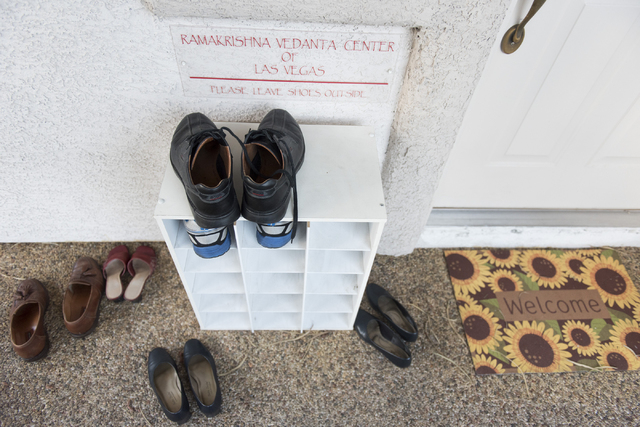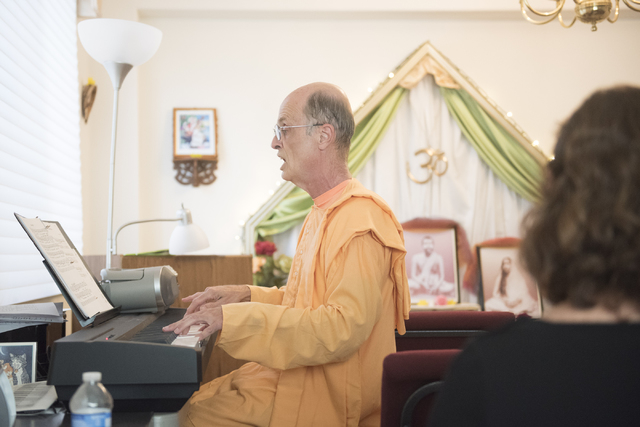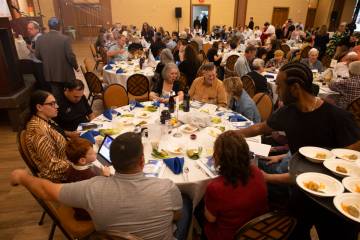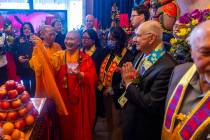Hindus nourish body and mind during Vedanta gatherings
Hang on, relentless multitaskers.
We’ll get to the rest of this story for which you’ve likely allocated only a minute or two to scan, peruse or perhaps even read to the end (if so, thank you in advance).
First, though, drop the cellphone in midtext and try this (with background chill-out music, if you have some handy):
Slowly fill the lungs with breath through the Ida, the left nostril, by stopping the right nostril with the thumb. Then slowly draw in the breath through the left; visualize sending the nerve current down the spinal column and striking on the last plexus (or) root chakra, the basic lotus that is triangular in form, the seat of the Kundalini.
Now, hold the current there for 12 or 16 counts, by closing both nostrils with thumb and forefinger. Then slowly throw it out through the right nostril by taking the thumb off, and let the breath out through the right nostril.
How ya feel, busy bees?
“Taking that long to exhale really does calm the mind down,” says William Scott, aka Swami Atmavidyananda, to 14 considerably relaxed “devotees” after conducting pre-prayer breathing exercises in the living room/makeshift sanctuary of a private home off West Charleston Boulevard.
Officially, it’s the Ramakrishna Vedanta Center of Las Vegas. Tucked inside a sedate, manicured home development, it’s also the definition of “hideaway.” Only the modest sign near the door identifies it as a gathering spot for local Hindu followers.
“It’s so open and about improving yourself and looking at people in a more positive light,” says regular attendee Vicki Miller. “You’re trying to live life on a higher level.”
Though many local Hindus anchor their religious life to the Hindu Temple of Las Vegas, others prefer the smaller, cozier get-togethers at homes such as this. Once a month, Swami Atmavidyananda, 66, drops in from the Vedanta Society of Southern California in Los Angeles (“Vedanta” is one of six orthodox schools of Hindu philosophy) to hold services (called “arati”), give lectures, encourage study of Hindu spiritual books and lead congregants in meditation and song.
“We’re giving people a context for them to keep their spiritual progress going. When I come out, it just gives an added impetus to the wheel of momentum,” says Atmavidyananda, whose name, bestowed on him when he took his vows as a swami, is translated as the divine self within (“Atma”), knowledge (“vidy”) and bliss (“ananda”).
“They also meet on their own (a short service on Fridays), so if they have questions that came up during classes, I can answer them. It’s a little more official and formal having a swami leading the class. But Hinduism is very home-based. It’s not the same pattern as Christian or Jewish or Islamic groups where there is more of a requirement to go (to a central structure) for your spiritual connection. Even so, they find it helpful for people to have what we call spiritual company to reinforce the fact you have common goals.”
A potluck dinner concludes the evening on a jovial note. (Not eating is not an option — on this night, this visitor’s polite refusal of a full plate was met with imploring, persistence and, finally, insistence.)
“In the Vedanta movement, I hate to abuse the word, but it’s mystical in the individual search for God, versus traditional religion where you go to church, get a lecture, leave and you’re the same person,” says Larry Newton. “This is working on oneself as you would if you were a monk in a monastery.”
Though born and raised Jewish, Newton says he appreciates the inclusionary spirit of Hinduism.
“With this philosophy, you can be of any faith and still practice,” he says. “When I come here, it’s like a recharge.”
Dotting a small shrine around photos of Hindu saints — including Ramakrishna, the 19th century Indian mystic and yogi who gives this order its name — are the traditional symbols for the five elements offered to God: ether (“akasha”), wind (“vaya”), fire (“tejas”), water (“ap”) and earth (“pritvi”). Centering the shrine is a plaque of the Om, the main Hindu symbol, embodying the first breath of creation.
Dressed in the traditional monastic robe of “gerua” (orange, representing the “fire of renunciation” of worldly pleasures), Atmavidyananda explains the origins and mechanics of pranayama, the Hindu tradition of breath meditation. Practitioners follow his lead, and a calm settles over the room, segueing into a service of prayer, song and chants — with Atmavidyananda accompanying on a small synthesizer — and then several minutes of silent meditation.
Finally, small flowers are passed around and, one by one, people step to the shrine, kneel and leave them as an offering to God.
“There are so many aspects to Hinduism and a lot of misunderstanding. When I talk to Hindu students that have come from all different parts of India, they have very different opinions about what it is and don’t even know that other people have different practices,” Atmavidyananda says.
Condensing a complex religion into a general mission statement, he explains it this way: “The basic idea in Hinduism is that divinity is within us. But we’re covered in a veil of ignorance that makes us think we’re just a body and a mind, that there is a birth date and there will be a death date and that creates fear in people. But in Hinduism, we turn inward to find the truth. We picture the archetypical energies in the universe as gods and goddesses, but use exemplars of spiritual teachings as role models.”
Vital elements of the religion include karma yoga, in which our actions are considered spiritual offerings, rather than reaping the benefits for ourselves — reducing the ego by serving others. Most importantly, there is Brahman, the central spiritual concept that is what the swami calls “the infinite, undivided, unchanging reality” behind everything.
“It’s very complicated,” he says. And rewarding to the modest but ardent devotees here.
“One of the processes of finding Brahman is through knowledge, and that attracts me a lot,” says follower Kal Bhattacharyya. “But this is not easy stuff. It’s like going to school, and what they’re talking about here is master’s level. It stimulates my intellect — and it’s lovely people and good food.”
Now, before you depart this story, do your mind, body and spirit a favor and revert back to the top. … Slowly fill the lungs with breath. ...




































